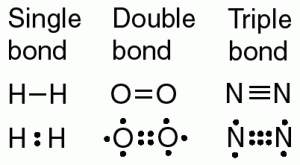The Salesperson as Chemist – Breaking the Bonds of Incumbency
April 22, 2017Personal The Offer The Company
You target an important prospect, assertively conceive and execute a sales campaign for years, without any progress. The prospect is “in bed” with your competition. It’s starting to wear on you.
If you haven’t done so already, maybe it’s time for a chemistry analysis. What kinds of bonds exist between the prospect and incumbent supplier?
The three common bonds in nature (see illustration) are matched by three bonds in selling:
- The salesperson – the hydrogen bond – often emotional
- The product/service – the oxygen bond – functional
- The company – the nitrogen bond – risk aversion
Let’s consider how to dislodge these bonds to dislodge the incumbent:
- The salesperson bond – hydrogen – the emotional bond
There are two kinds of buyers – satisficers and maximizers. Satisficers set minimum standards to enshrine incumbent suppliers. Maximizers seek the best possible offer for the organization.
There is no problem with a buyer/seller personal connection, as long as the salesperson’s product/service is optimal for the buying organization.
We frequently observe the buyer protecting a suboptimal vendor, because of a personal relationship and to defend past buying decisions. The foxes are guarding the henhouse. For instance: a certain component has a 16 week lead time. A new supplier can cut that lead time in half. Yet, when the buyer writes the spec, he stipulates 16 weeks lead time, to protect the incumbent.
In this situation, you may need to go above the buyer – to the C Suite – to find someone who cares about optimal offers. It’s often a good idea to start your campaign in the C Suite.
With multiple decision-makers you need to do a hydrogen bond analysis for all players touching the decision.
- The product/service bond – oxygen – the functional bond
The core of any offer is material difference – the difference so strong it motivates a change in prospect behavior. Examples of desirable changed behavior can be: a meeting, a plant tour, an introduction, a reference check.
What is your material difference? Your Raison d’être?
Powerful material difference statements (MD) usually have these qualities:
a) Compelling – generally edgy
b) Quantifiable – how much money/time you save
c) Specific Detail – to make it credible
Examples of MD statements include:
1) Billing service for martial arts studios – we save you 5 hours a week for every 75 members.
2) Architect – we save you 10-20% on construction drawings
There is a paradox of MD. Without it, there is no need to take a salesperson seriously. At best, you are a pricing exercise.
If you demonstrate a MD, the satisficing buyer (with a strong hydrogen bond) will display skepticism – they don’t believe what you say. This is why you need to be prepared to attack the nitrogen bond.
3) The company – the nitrogen bond – risk aversion
Companies avoid change – including changing vendors – to avoid risk. The incumbent vendor is a known quantity; the prospective vendor is an unknown.
Psychologists, like Kahnemann, have studied our behavior and report we are risk averse – we not only avoid risk, often we unreasonably avoid risk. We make bad bets, choosing safety vs. a reasonable expectation of gain.
Companies following risk aversion to an extreme – avoiding innovation – can become obsolete. The prospect’s need to innovate is another reason to target the C Suite. Risk adverse decision-makers in operations may not be the innovation we bring.
Although C Suite executives are usually more open to innovation, they aren’t pushovers. Your MD may sound compelling, but these executives will still want to minimize risk.
This is why you need the best proving kit available – to meet the reasonable needs of the risk averse skeptic. Your proving kit contains: testimonials, both written and video; case histories; PR; scorecards from existing customers; samples
With an impeccable proving kit, you can break the nitrogen bond.
Conclusion on timing
When should you do this chemical bond analysis? Three years into a sales campaign? Ideally, you qualify the prospect in the first 1-2 meetings, to determine which bonds must be broken, and whether you have the wherewithal to break those bonds.
